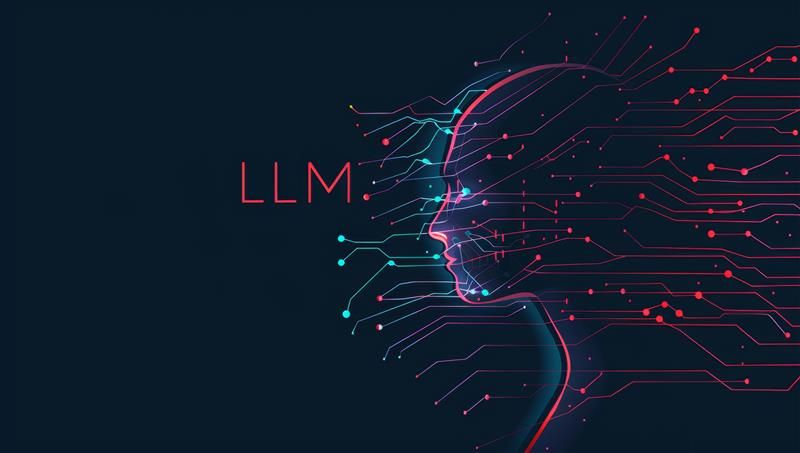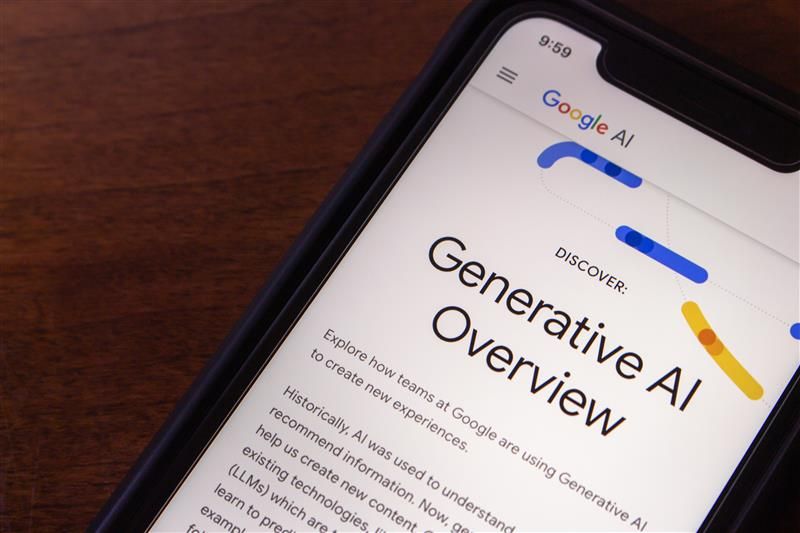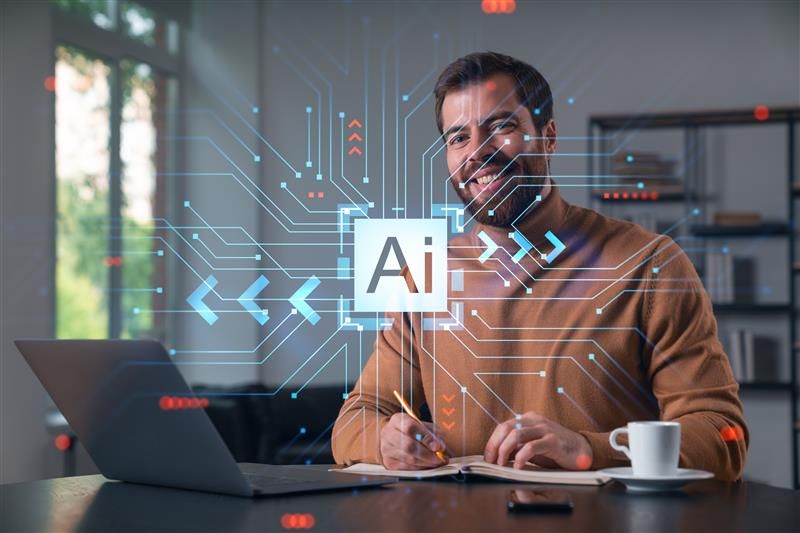Artificial Intelligence (AI) has long been a game-changer in various industries, but its influence on software development is particularly profound. Generative AI for software development is rapidly changing the landscape, offering unprecedented efficiency, creativity, and innovation. As businesses across the globe embrace AI-driven methodologies, the software industry stands on the brink of a massive transformation. This blog delves into 10 significant ways generative AI is revolutionizing the software industry.
Understanding Generative AI in Software Development
Before exploring the transformative impacts, it’s crucial to understand what generative AI is and how it applies to software development. Generative AI refers to algorithms, like neural networks, that can generate new data or content based on training data. In the context of software development, these algorithms can create code, design software architectures, optimize algorithms, and even automate testing processes.
Generative AI uses vast datasets to train models, allowing it to produce software components that meet specific requirements or solve particular problems. This technology is the cornerstone of the future in AI-driven software development.
What is Generative AI in Software Development?
Generative AI in software development refers to the application of artificial intelligence (AI) technologies that can autonomously create new software components, such as code, designs, and even entire software systems. Unlike traditional AI, which typically follows pre-defined rules or models to solve specific problems, generative AI uses advanced algorithms, like neural networks and deep learning, to generate new and innovative outputs based on the data it has been trained on. In the context of software development, generative AI can be employed in various stages of the development lifecycle, including:
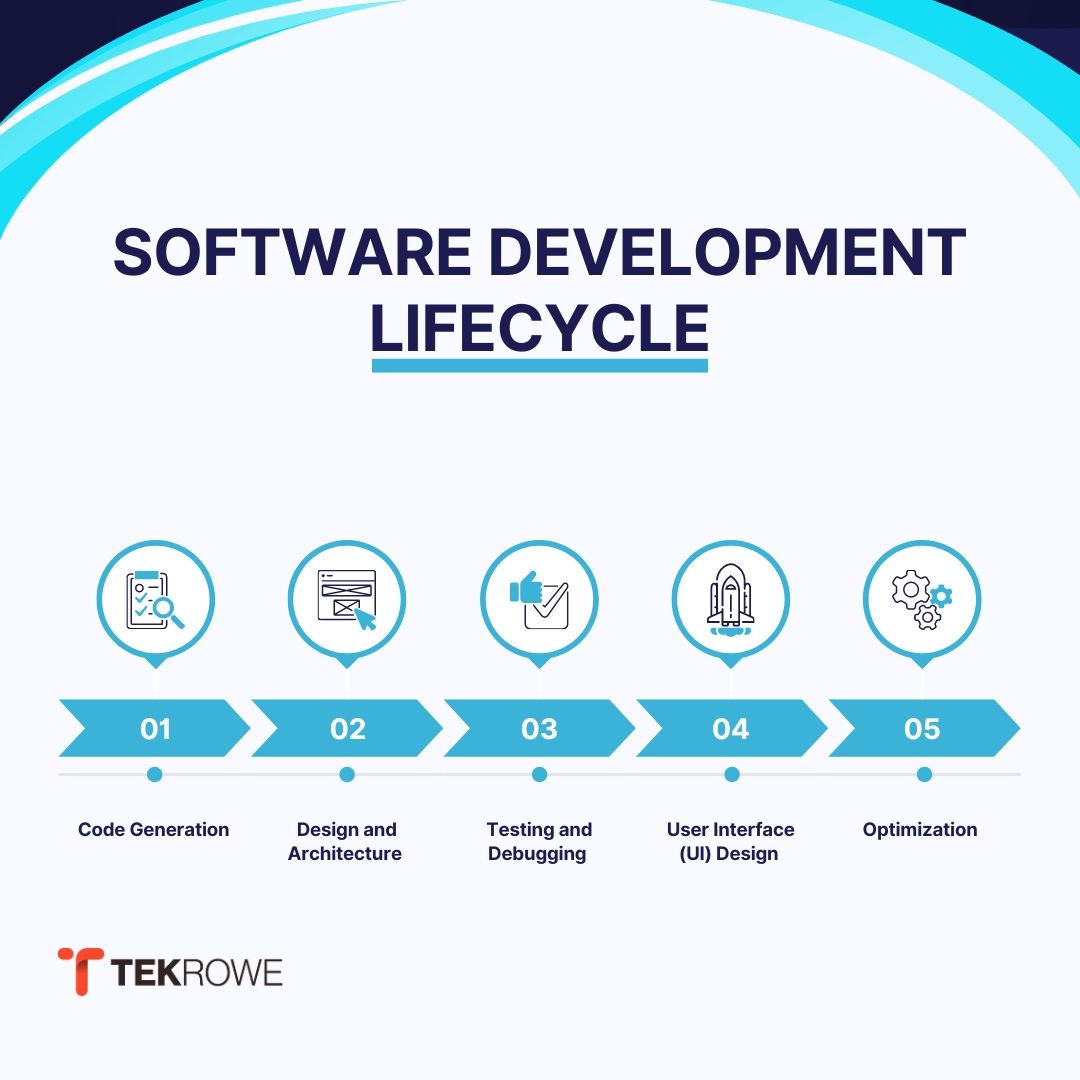
- Code Generation: Automatically writing code based on high-level inputs or specifications provided by developers. For instance, an AI tool might generate boilerplate code or suggest code snippets as a developer types.
- Design and Architecture: Creating software designs or suggesting optimal architectures based on the analysis of existing software patterns and best practices.
- Testing and Debugging: Generating test cases, identifying potential bugs, and even offering solutions or fixes for identified issues.
- User Interface (UI) Design: Developing user interfaces that adapt dynamically to user preferences or generating multiple design options for developers to choose from.
- Optimization: Analyzing and optimizing existing codebases to improve performance, reduce resource consumption, or enhance maintainability.
The key advantage of generative AI in software development is its ability to significantly speed up the development process, reduce the risk of human error, and enable the creation of more innovative and efficient software solutions. As this technology continues to advance, it is expected to become an integral part of how software is developed, maintained, and improved, making it a crucial tool for developers and organizations aiming to stay competitive in a rapidly evolving tech landscape.
10 Ways Generative AI is Transforming the Software Industry
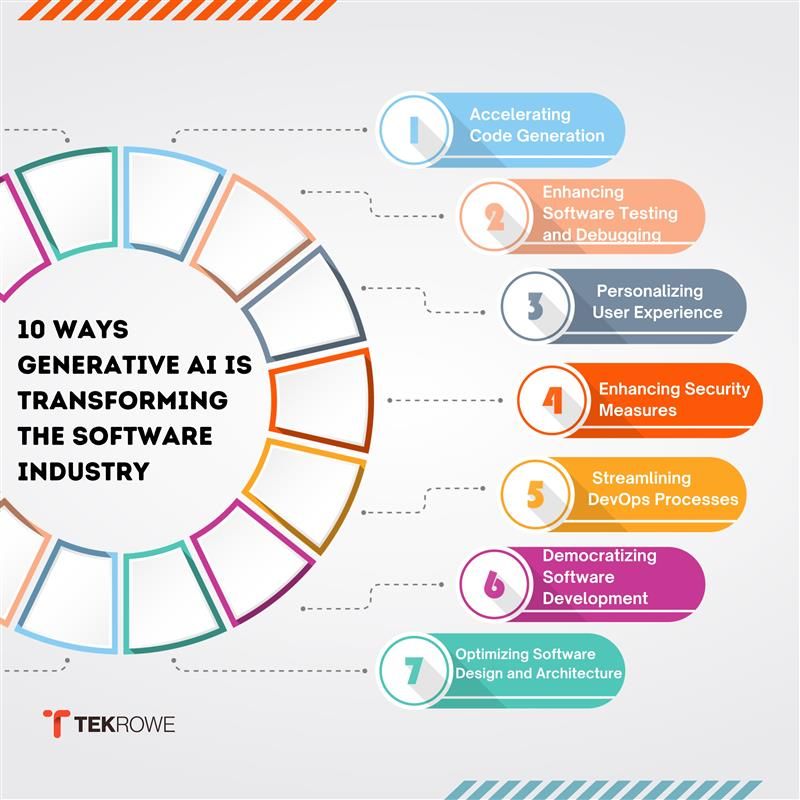
1. Accelerating Code Generation
One of the most direct impacts of generative AI in software development is its ability to accelerate code generation. Traditional coding practices can be time-consuming, requiring developers to write, test, and debug extensive lines of code. Generative AI can significantly speed up this process by automatically generating code snippets based on user input or high-level design requirements.
For instance, AI-powered tools like GitHub Copilot can write code in real-time, suggesting lines of code as developer’s type, thereby streamlining the coding process. This not only reduces the time to market but also minimizes human error, leading to more robust and reliable software.
- Automation of Code Writing: Generative AI tools like GitHub Copilot can suggest and generate code snippets in real-time, significantly speeding up the coding process.
- Reduction in Time to Market: By automating repetitive coding tasks, companies can deploy products faster, maintaining a competitive edge.
- Minimization of Human Error: AI-generated code reduces the likelihood of mistakes, leading to more robust and reliable software.
2. Enhancing Software Testing and Debugging
Software testing is a critical phase in the development lifecycle, ensuring that applications run smoothly and without bugs. Traditional testing methods involve manually writing test cases, which can be labor-intensive and prone to oversight. Generative AI introduces a new paradigm by automating the creation of test cases and even predicting potential bugs before they manifest.
AI-driven tools can analyze codebases, identify weak spots, and generate test scenarios that a human might overlook. Moreover, generative AI can simulate various user interactions to test how the software would behave in real-world scenarios. This automation reduces the time and cost associated with testing while increasing the thoroughness and accuracy of the process.
- Automated Test Case Generation: Generative AI can automatically create test cases, simulating various user interactions and scenarios.
- Proactive Bug Detection: AI tools can predict potential bugs by analyzing codebases, helping developers fix issues before they escalate.
- Comprehensive Testing: AI-driven tools can cover edge cases that human testers might overlook, ensuring thorough testing.
3. Optimizing Software Design and Architecture
The design and architecture of software are fundamental to its performance, scalability, and maintainability. Traditionally, software architects rely on experience and intuition to make design decisions. However, artificial intelligence in software development is reshaping this aspect by providing data-driven insights that can optimize software architectures.
Generative AI tools for software development can analyze large datasets of existing software architectures, identify patterns, and suggest optimal designs that balance performance, cost, and scalability. These AI-driven insights help developers create more efficient and effective software systems, reducing the likelihood of design flaws that could impact future scalability or performance.
- Data-Driven Design Suggestions: Generative AI analyzes existing software designs to suggest optimized architectures.
- Balanced Decision-Making: AI provides insights that help developers balance performance, scalability, and cost in their designs.
- Reduced Risk of Design Flaws: Automated design recommendations minimize the chances of performance bottlenecks or scalability issues.
4. Personalizing User Experience
In today’s digital age, user experience (UX) is paramount. Software that offers a personalized experience tends to have higher user engagement and satisfaction. Generative AI plays a pivotal role in creating personalized user experiences by analyzing user behavior and preferences.
AI algorithms can tailor the interface and functionality of software applications to individual users, enhancing their interaction with the software. This personalization goes beyond simple customization, offering dynamic adjustments that improve usability and accessibility for each user.
For example, AI can adapt the interface of a mobile app based on the user's usage patterns, making frequently used features more accessible. Such adaptability not only improves user satisfaction but also fosters greater loyalty to the software.
- Dynamic Interface Adjustments: Generative AI tailors software interfaces based on individual user behavior and preferences.
- Enhanced User Engagement: Personalized experiences lead to higher user satisfaction and loyalty.
- Continuous Learning and Adaptation: AI-driven software evolves over time, improving its usability based on user interactions.
5. Revolutionizing Software Maintenance
Maintenance is a significant part of the software lifecycle, often consuming more resources than the initial development. Traditional maintenance requires ongoing manual efforts to fix bugs, update features, and ensure compatibility with new platforms. Generative AI is transforming this process by enabling predictive maintenance.
AI-driven software development tools can monitor software performance in real-time, identify potential issues before they become critical, and even suggest or implement fixes automatically. This proactive approach minimizes downtime, reduces maintenance costs, and extends the life of the software.
For instance, AI can detect that a particular feature is causing performance bottlenecks and suggest optimizations before user’s experience significant slowdowns. By automating much of the maintenance process, generative AI allows development teams to focus on innovation rather than firefighting.
- Predictive Maintenance: Generative AI monitors software in real-time, identifying potential issues before they become critical.
- Automated Fixes: AI can suggest or implement optimizations automatically, reducing the need for manual maintenance.
- Cost and Time Efficiency: Proactive maintenance lowers downtime and overall maintenance costs, extending software longevity.
6. Facilitating Collaboration and Knowledge Sharing
Software development is often a collaborative effort, with teams working together to build complex systems. However, collaboration can be hindered by communication gaps, especially in large, distributed teams. Generative AI is enhancing collaboration by facilitating better communication and knowledge sharing among developers.
AI tools can analyze code repositories, documentation, and communication logs to identify knowledge gaps and suggest relevant resources or experts within the team. They can also automatically generate documentation for code, making it easier for team members to understand and build on each other’s work.
This AI-driven approach to collaboration ensures that all team members are on the same page, reducing misunderstandings and improving overall productivity.
- Improved Communication: Generative AI analyzes team communication to identify gaps and suggest relevant resources or experts.
- Automatic Documentation: AI can generate and update documentation, making it easier for team members to understand and build on each other’s work.
- Enhanced Team Efficiency: Better knowledge sharing and collaboration lead to more productive and cohesive development teams.
7. Streamlining DevOps Processes
DevOps practices integrate software development and IT operations to shorten the development lifecycle and deliver high-quality software continuously. Generative AI is playing a crucial role in optimizing DevOps processes by automating repetitive tasks and enhancing decision-making.
For example, AI can automate the deployment pipeline, ensuring that code is continuously integrated, tested, and deployed with minimal human intervention. It can also analyze performance metrics and suggest improvements to the DevOps workflow, leading to faster and more reliable software releases.
Generative AI tools for software development are becoming an indispensable part of DevOps, enabling teams to achieve greater efficiency and consistency in their delivery processes.
- Automation of CI/CD Pipelines: Generative AI automates the continuous integration and deployment processes, ensuring faster and more reliable software releases.
- Performance Optimization: AI-driven tools analyze deployment data and suggest improvements to the DevOps workflow.
- Predictive Analysis: AI can predict the success of future releases and recommend optimizations to the development process.
8. Enhancing Security Measures
Security is a top priority in software development, especially as cyber threats become increasingly sophisticated. Generative AI is transforming how developers approach security by automating vulnerability detection and response.
AI-driven tools can scan codebases for security vulnerabilities, suggest patches, and even automatically apply fixes. They can also simulate potential cyber-attacks to test the software’s defenses and recommend improvements. This proactive approach to security ensures that software is more resilient against threats, protecting both the developers and the end-users.
For example, an AI-driven security tool might identify a vulnerability in a web application and automatically generate a patch before the vulnerability can be exploited by malicious actors. This level of automation and foresight is crucial in today’s threat landscape.
- Automated Vulnerability Detection: Generative AI scans codebases for security vulnerabilities and suggests or applies fixes.
- Simulation of Cyber Attacks: AI tools can simulate potential attacks to test the software’s defenses, ensuring robust security.
- Proactive Security Management: Automated security measures reduce the burden on developers, allowing them to focus on building features.
9. Driving Innovation in AI-Driven Software Development
The influence of generative AI goes beyond just improving existing processes; it’s also driving innovation in AI-driven software development itself. Generative AI tools are being used to create new types of software that were previously unimaginable, such as AI-generated art, music, and even video games.
These tools allow developers to explore new frontiers in software design, pushing the boundaries of what’s possible. For instance, generative design techniques can create software that adapts and evolves over time, learning from user interactions to improve functionality and user experience continuously.
This innovative approach to software development is opening up new opportunities for creativity and experimentation, allowing developers to build applications that are not only functional but also uniquely engaging.
- Creation of New Software Types: Generative AI is used to develop AI-generated art, music, and games, pushing the boundaries of creativity.
- Adaptive Applications: AI-driven software that learns and evolves over time provides personalized and engaging user experiences.
- Exploration of New Frontiers: Developers can use generative AI to experiment with novel software designs and functionalities.
10. Democratizing Software Development
Perhaps one of the most profound impacts of generative AI for software development is its potential to democratize the industry. Traditionally, software development has been the domain of highly skilled programmers. However, generative AI tools are making it easier for non-programmers to create software.
Tools like low-code and no-code platforms, powered by generative AI, enable users to build applications by simply dragging and dropping components, without needing to write a single line of code. This democratization is opening up software development to a broader audience, allowing businesses and individuals to create customized software solutions that meet their specific needs.
By lowering the barriers to entry, generative AI is fostering a new wave of innovation and entrepreneurship, as more people are empowered to bring their software ideas to life.
- Low-Code/No-Code Platforms: Generative AI powers platforms that allow non-programmers to create software through intuitive interfaces.
- Broadened Access to Software Development: Individuals and small businesses can now develop custom software solutions without extensive coding knowledge.
- Fostering Innovation and Entrepreneurship: The democratization of software development enables more people to bring their ideas to life, driving industry-wide innovation.
Need Help with Your Business
Contact Us NowConclusion
The integration of generative AI for software development is not just an incremental improvement; it’s a transformative shift that is revolutionizing the entire industry. From accelerating code generation to enhancing security, generative AI is driving efficiency, innovation, and accessibility in ways that were previously unimaginable. As the technology continues to evolve, its impact on AI-driven software development will only grow, shaping the future of how software is created, maintained, and experienced. Embracing generative AI is no longer a choice but a necessity for developers and businesses looking to stay competitive in the rapidly evolving software landscape.
FAQs
How does generative AI accelerate software development?
Generative AI for software development accelerates the process by automatically generating code, optimizing designs, and automating testing, significantly reducing the time and effort required from developers.
What impact does AI have on software maintenance?
AI-driven software development tools enable predictive maintenance by monitoring software performance, identifying issues before they become critical, and suggesting or implementing fixes automatically, reducing downtime and maintenance costs.
Can generative AI improve software security?
Yes, generative AI enhances security by automating vulnerability detection, suggesting patches, and even applying fixes automatically, ensuring that software is more resilient against cyber threats.
How does generative AI contribute to personalized user experiences?
Generative AI analyzes user behavior and preferences to tailor software interfaces and functionalities, providing dynamic adjustments that improve usability and accessibility for individual users.
What role does generative AI play in DevOps?
Generative AI optimizes DevOps processes by automating repetitive tasks, analyzing performance metrics, and enhancing decision-making, leading to faster and more reliable software releases.
Is generative AI making software development accessible to non-programmers?
Yes, generative AI is democratizing software development through low-code and no-code platforms that allow non-programmers to build applications without needing to write code, making software creation more accessible.

